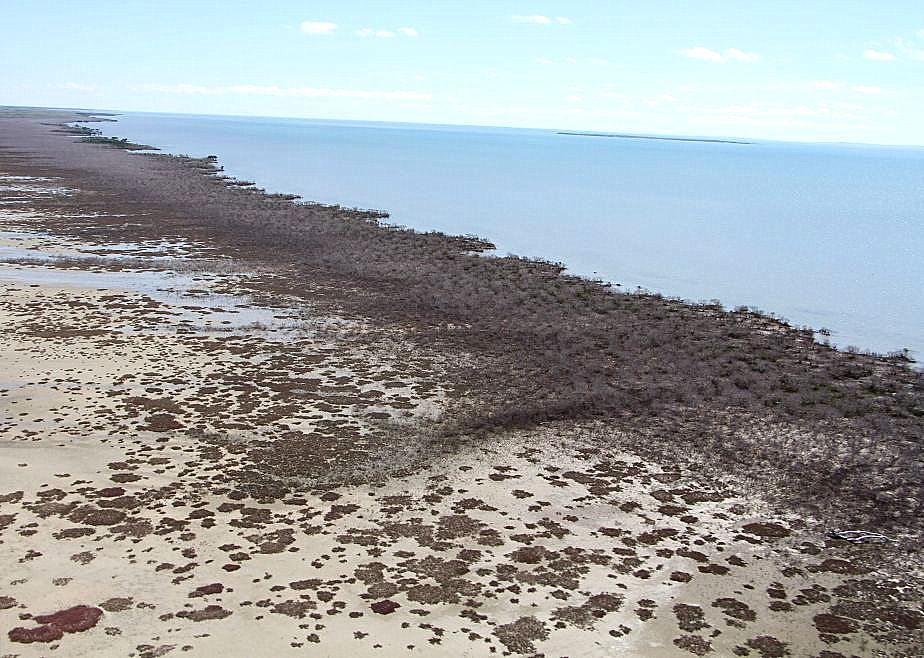Fading Colors of Australia
Western Australia kelp forest, 2011 (credit: University of Western Australia/Thomas Wernberg)
Australia is a very colorful place with all its unique birds, plants, lush forests, and marine life, as well as the vast landscape itself. Sadly, some of these brilliant Aussie colors has faded.
Well removed from most people's attention, major deforestation has happened there. This wholesale loss is not like that seen in tropical rainforests of the Amazon or on Borneo but occuring near and under the oceans surrounding the continent. The consequences will be far-reaching if ecological boundaries are permanently crossed.
Reporting in Science, a dramatic climate-driven shift has been observed in a huge marine ecosystem, the Great Southern Reef, that stretches from Tasmania to the coastlines north of Perth on the Indian Ocean. The reef's defining kelp forests are dying and being replaced by seaweed turfs. Field research in Western Australia shows that significant warming of the temperate kelp forests has resulted not only in their collapse, but also in a shift in the marine community's composition. In a very short time span, the kelp has died and been replaced by other species preventing re-establishment. The WA researchers showed:
"after decades of ocean warming, extreme marine heat waves forced a 100-kilometer range contraction of extensive kelp forests and saw the kelp species replaced by seaweeds, invertebrates, corals, and fishes characteristic of subtropical and tropical waters. This community-wide tropicalization fundamentally altered key ecological processes, suppressing the recovery of the kelp forests."
Thomas Wernberg, lead author from the University of Western Australia, noted:
Temperatures exceeded anything previously experienced by these forests and they collapsed, allowing algae, tropical and subtropical fish, seaweed, and coral to increase rapidly. We analysed kelp forest data collected between 2001 and 2015 along more than 1200 miles of the Western Australian coastline and it shows how the heatwave, combined with decades of ocean warming, has broken down biogeographic boundaries with lasting consequences.
These productive, biologically diverse, kelp-dominated ecosytems have been replaced by new and lesser productive marine species. The situation is explained here:
Similarly, another coastal forest in Australian forest has undergone major alterations. Coastal mangrove forests fringe many shorelines extending well into tidal zones where they serve as critical nurseries for fish species, are used for recreational and commercial fishing. The mangroves also represent protective barriers against cyclones that frequently hit Australia's coastal zones.
News reports show that nearly 10,000 hectares (~25,000 acres) of mangroves have died across a wide stretch of coastline reaching from Queensland west across to the Northern Territories. The dieback has again occurred within an extremely short period of one month. This decline appeared at the same time as severe bleaching of corals happened on the Great Barrier Reef. Both were a response to stresses caused by an el nino weather pattern and higher ocean temperatures. Some of the damage to these remote mangroves that data and imagery on the extent of the dying forests had to be obtained from satellites.
Quoted in the ABC, researcher Norm Duke of Queensland's James Cook University said: "no doubt the mangrove dieback was related to climate change and it is 'world-first' in terms of the scale of the mangroves that have died."

Mangrove die-back, Gulf of Carpenteria, Queensland, 2016 (photo: Norm Duke, JCU)
The diversity of an ecosystem is often celebrated as a strength and a sign of resilience. However, this diversity can be dramatically affected if it is dependent on one or a limited number of key elements in the ecosystem: a dominant growth-form (kelp or mangrove forests), a dominant physical structure (coral reefs), or a stable coastal temperature (marine tidal zones). Remove one of these key elements and a collapse can occur and recovery may not be possible without major interventions.
Along with the loss of marine forests, the diversity of colors or animals and plants associated with all other the dependent species is lost as well. The songwriter Enda Kenny has written a soulful song of his own artistic impressions about the Colours of Australia fading:
Ecosystem collapse is impressive, very sad, and should be concerning to more than just Australians.
WHB